MOUNT WASHINGTON
What up Road Trip Warriors!? I am so excited to share with you all the most exciting hike I have done in the Northeast! I hiked Mount Washington, also known as the world’s deadliest small mountain, up the Tuckerman Ravine. The landscape on this hike was the most visually striking I have seen in the east. The cragged peaks and bare mountain tops reminded me of the Rockies out West. Waterfalls and ice cascaded down Tuckerman Ravine. I will try to share as much information as I can and also some tips on how to stay safe whilst hiking this beast of the east!
Summary of Mount Washington
- Difficulty: Strenuous
- Length (Tuckerman Ravine Trail): 8.4 miles round trip
- Elevation: 6,288′ above sea level
- Hiking Time: It took about four hours to reach the summit from the trailhead. We took water breaks as needed and stopped at the Hermit Lake Shelter 2.4 miles into the hike to take pictures. It isn’t a long hike, but it is steep in its entirety. We spent about 45 minutes in the summit building, grabbing souvenirs from the store and a snack from the food bar. We spent another 30 minutes exploring the summit, taking photos of the surrounding mountains and the trains that climb to the top. It took us about three hours to get back to the trailhead. We started at 6:45 AM and made it back to the car by 3:30 PM.
- Elevation Gain: Over 4,000′
- Photo Opportunities: There are so many scenic areas along this hike. The scenes are breathtaking. There is a captivating waterfall ten minutes from the trailhead. From the Hermit Lake Shelter there are craggy peaks that tower above you. A little further along the trail after the shelter, you’ll see Tuckerman Ravine in the distance. At this time of year, multiple waterfalls cascade down the ice-covered headwall. As you climb Tuckerman Ravine, the views continue to open up behind you. Then, there is the summit of Mount Washington which offers commanding views of the entire area. On a clear day (which we were lucky enough to have), one can see New Hampshire, New York, Vermont, Massachusetts, and Maine as well as into Canada!!
Trailhead/Address to Pinkham Notch
The trailhead for the Tuckerman Ravine Route can be found behind the Pinkham Notch Visitor Center. It is relatively easy to find if you plug in “Pinkham Notch” into your GPS. The address is 361 NH-16, Gorham, NH 03581. The visitor center opens at 6:30 AM and closes at 9:00 PM. There is food you can order inside that consists of subs, soup, and more. There is a souvenir shop as well with a topographic map of the area and info on what the weather is like for the day. Lastly, there is a door from the parking lot that leads to the lower section of the building. The bathrooms, vending machines, and trail register are located here. Make sure you sign in!
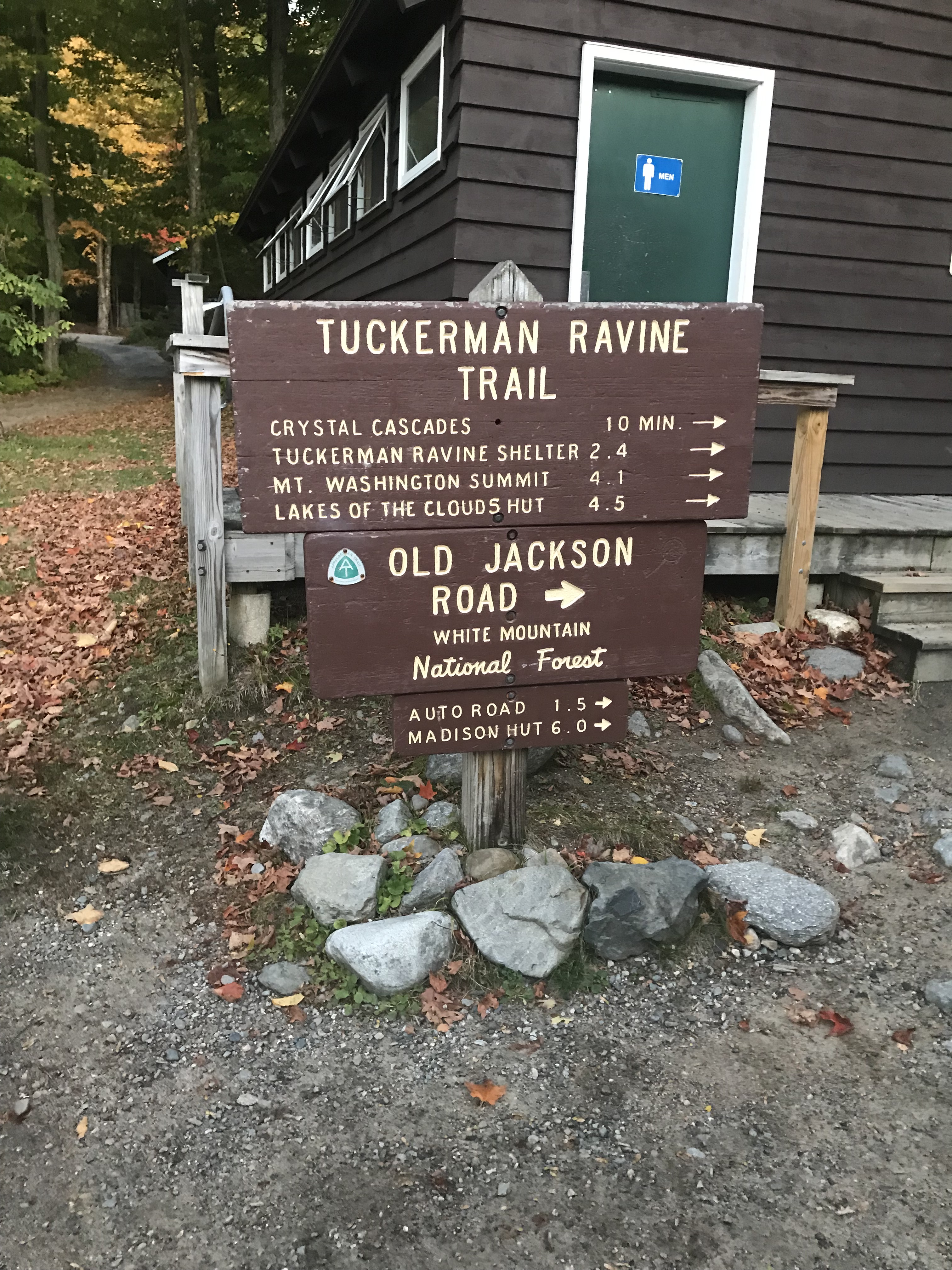
Beginning the Trek up mount washington
The hike begins climbing almost immediately. You’ll make your way up the dirt and rock-littered trail eventually coming across a large wooden bridge. Cross it and shortly after, there is a lookout to observe a beautiful waterfall cascading through the woods. We stopped here to take some pictures on our phones before moving on. If you have some spare time, I suggest taking a moment to appreciate the falls. This is just a quick iPhone pic because I didn’t feel like taking my camera out so soon into the hike.
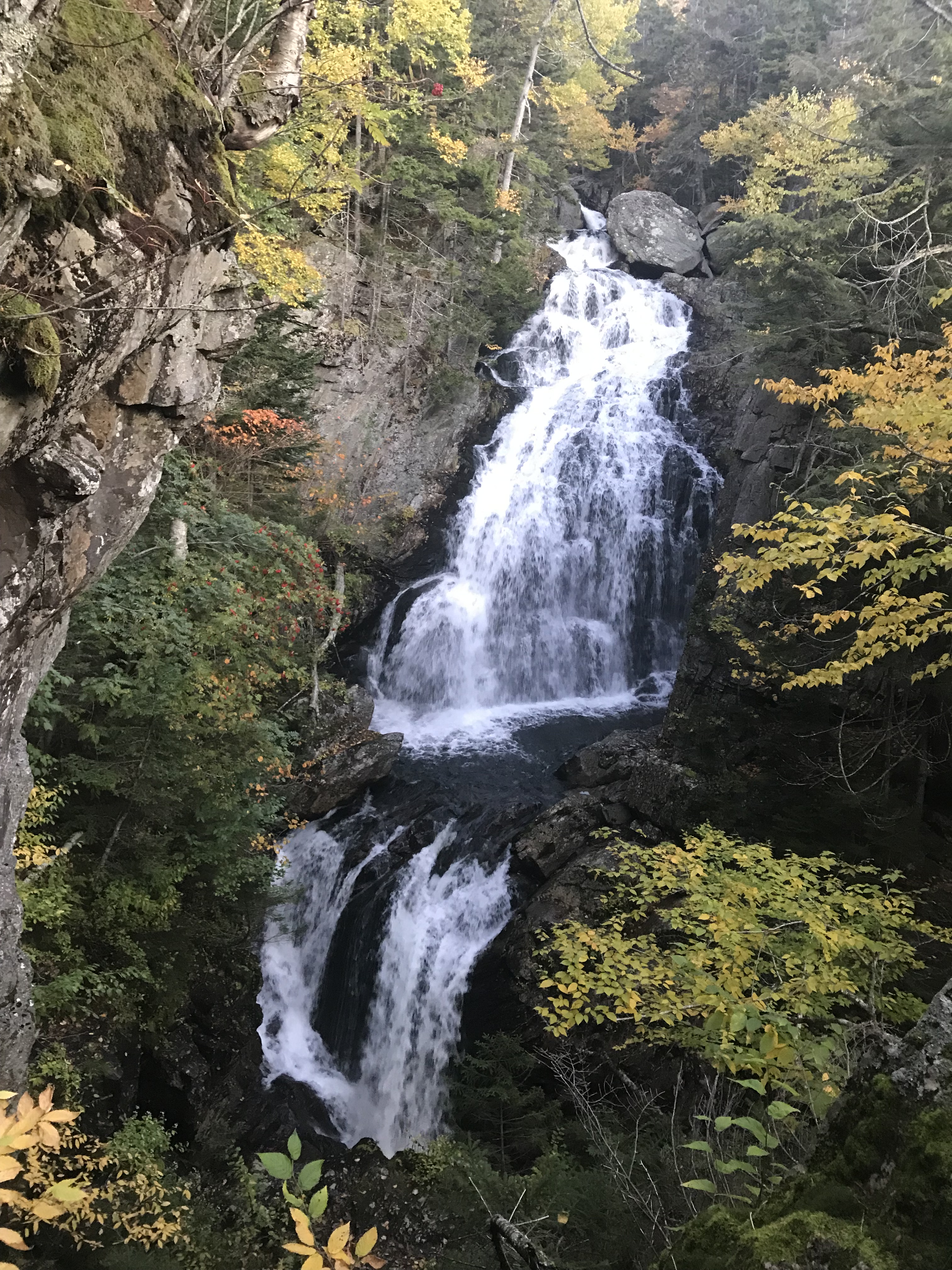
Keep Climbing, Two More Bridges
The Tuckerman Ravine trail is pretty straight-forward for the initial 2.4 miles to the Hermit Lake Shelter. You will continue your ascent up the trail and cross two more wooden bridges along the way. You’ll sporadically see the summit of Mount Washington through the trees. It can seem a little intimidating, but on a blue-bird day, it is beyond worth the struggle. As you get closer to the Hermit Lake Shelter, the peaks that start to tower over you are craggy and bare. Like I mentioned earlier, they reminded me of the Rocky Mountains. Check out a picture of them below!

Hermit Lake Shelter (2.4 miles in)
It took us about two hours to reach the Hermit Lake Shelter. The shelter has a large wooden deck with benches that you can rest on if needed. We stopped here for about fifteen to twenty minutes to break out our cameras and shoot the surrounding landscape. There is also a snow ranger quarters located here. The sign states the elevation you’re at which is 3,800′ above sea level. The wooden ranger quarters with the mountains towering behind it made for an aesthetic scene.
While you’re here, there are also bathrooms and a water pump (you have to actually hand pump it yourself which is pretty cool) if you need to use either of those. From this point, you have 1.8 miles left until you reach the summit of Mount Washington.
Make Way to Tuckerman Ravine
Tuckerman Ravine is probably the most visually striking you will encounter while hiking Mount Washington up this route. Multiple waterfalls poured over the headwall, flowing around ice formations and through the valley below. Tuckerman Ravine is a glacial cirque formed during the last ice age. Snow will stay in the ravine well into summer, occasionally forming a snow arch by the trail. The trail is closed in the Spring at the ravine floor until it is free of snow and there is no danger of falling ice. This is usually sometime in July. Tuckerman ravine is famous for its skiing and also for the perils that have come with it.
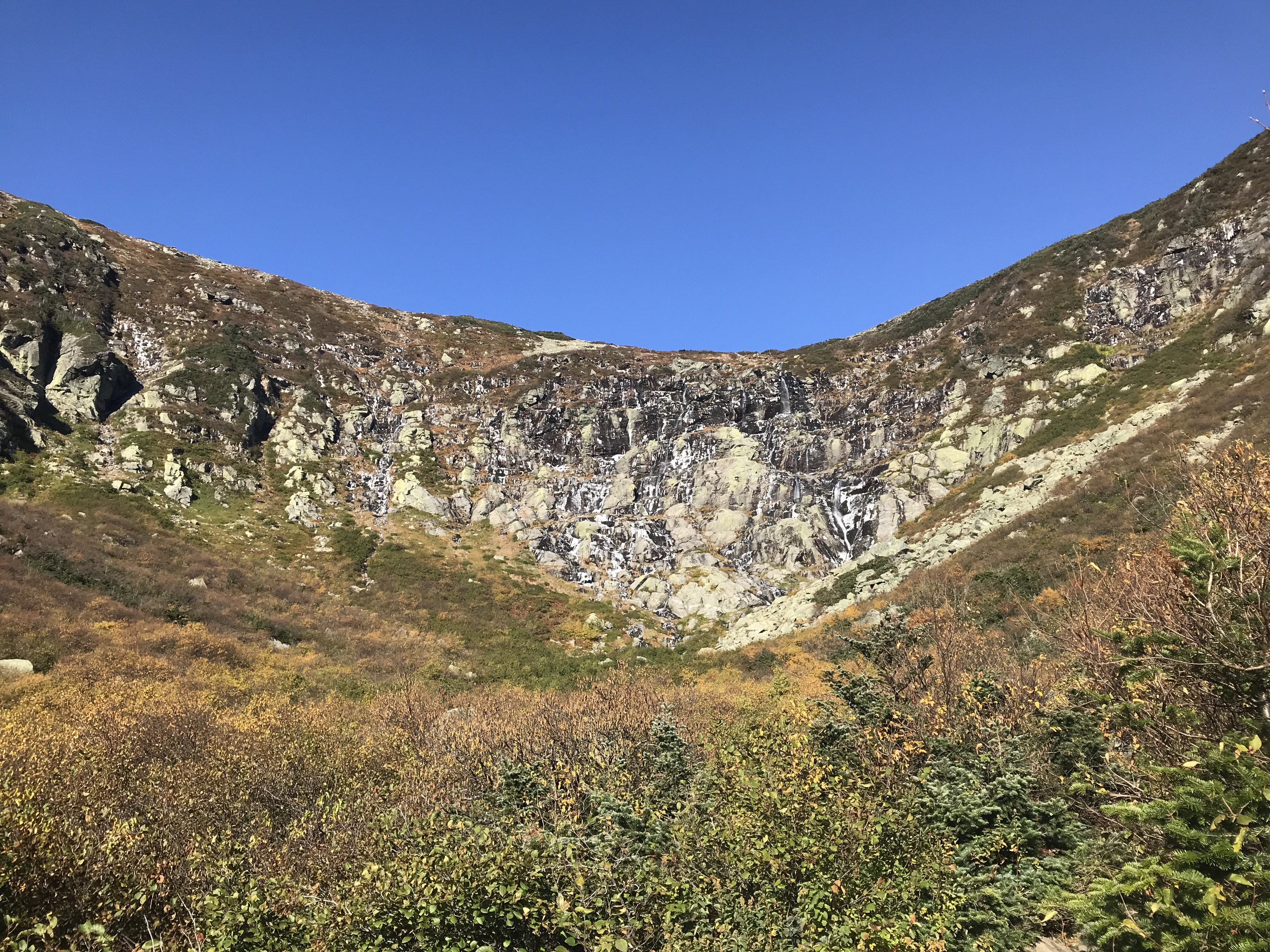
Multiple people have been killed in Tuckerman Ravine. Some of the reasons of death include falling off of the headwall, being struck by falling ice, losing control while skiing, and heart attacks. Despite being the most direct and well-protected trail to the summit, please take caution. Mount Washington has claimed over one hundred-and-fifty lives.
Climbing Along the Headwall of Tuckerman Ravine
Once you reach the floor of the ravine, the trail bears right. It is up a well-constructed rock pathway. Yellow paint on the boulders will aid you with staying on trail. There are numerous spots while climbing where water pours over the rocks making it slippery. You do NOT want to rush up and slip off of a ledge.
When I was hiking up it, it was early in the morning and there was a significant amount of ice. In some sections there was ice falling onto the trail from above. I witnessed a young man and woman having to cover their heads as small chunks of ice came hurling towards them. Again, this hike can be unpredictable and you must take caution.
The rock path will take you across the waterfall and up over the headwall. The vistas at this point in the hike are otherworldly. On a clear day like I had, mountains continue for miles, painted in fall colors. It is difficult to capture the landscape’s beauty and feeling you get witnessing it in an image.
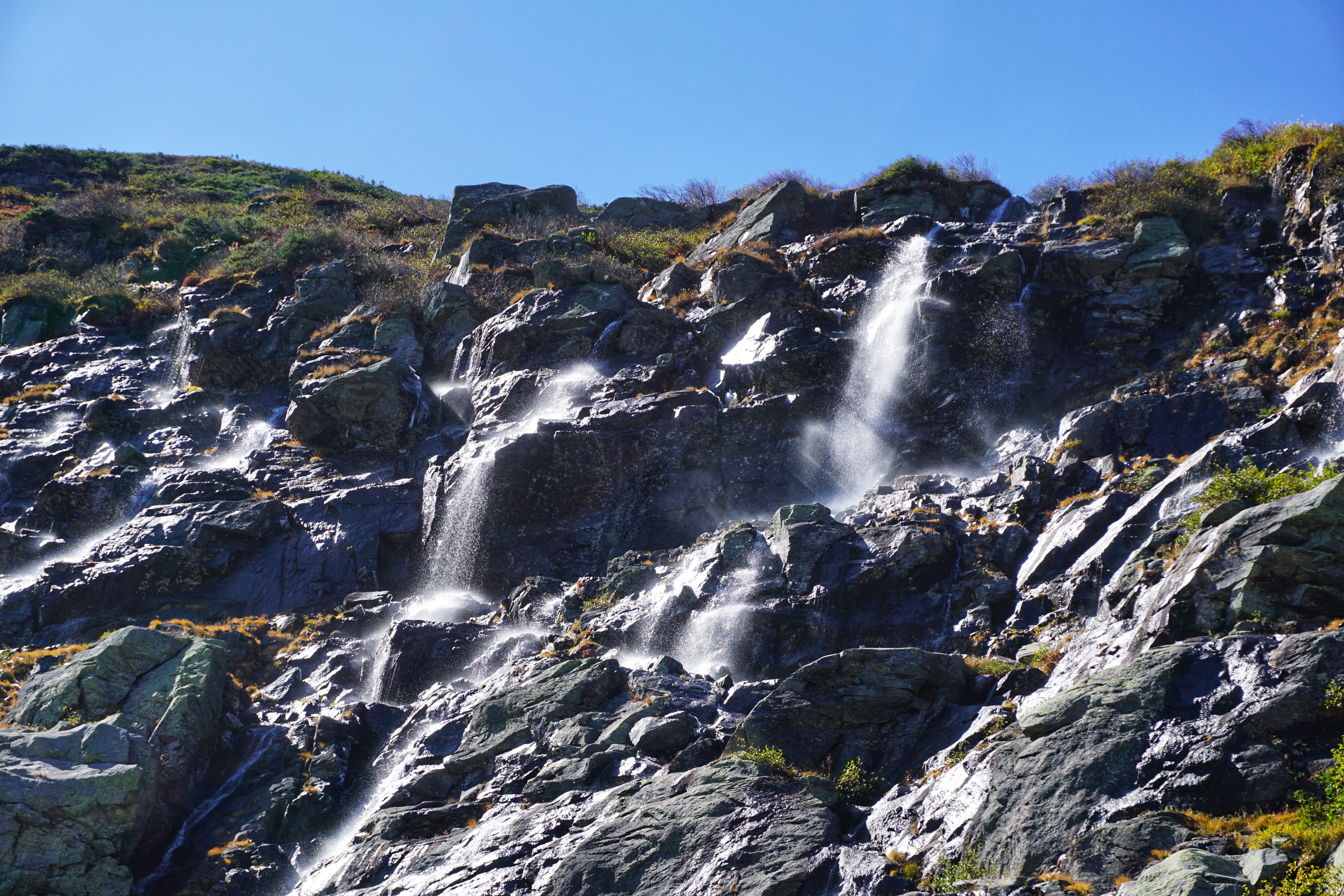
Wooden Signs Marking .8 and .6 of a Mile to the Summit
After getting over the headwall, you should come across two wooden signs in rather quick succession. One will state that you are .8 of a mile away from the summit and the other further ahead will state .6 of a mile away. Here are photos of both of them, but they are easy to find.
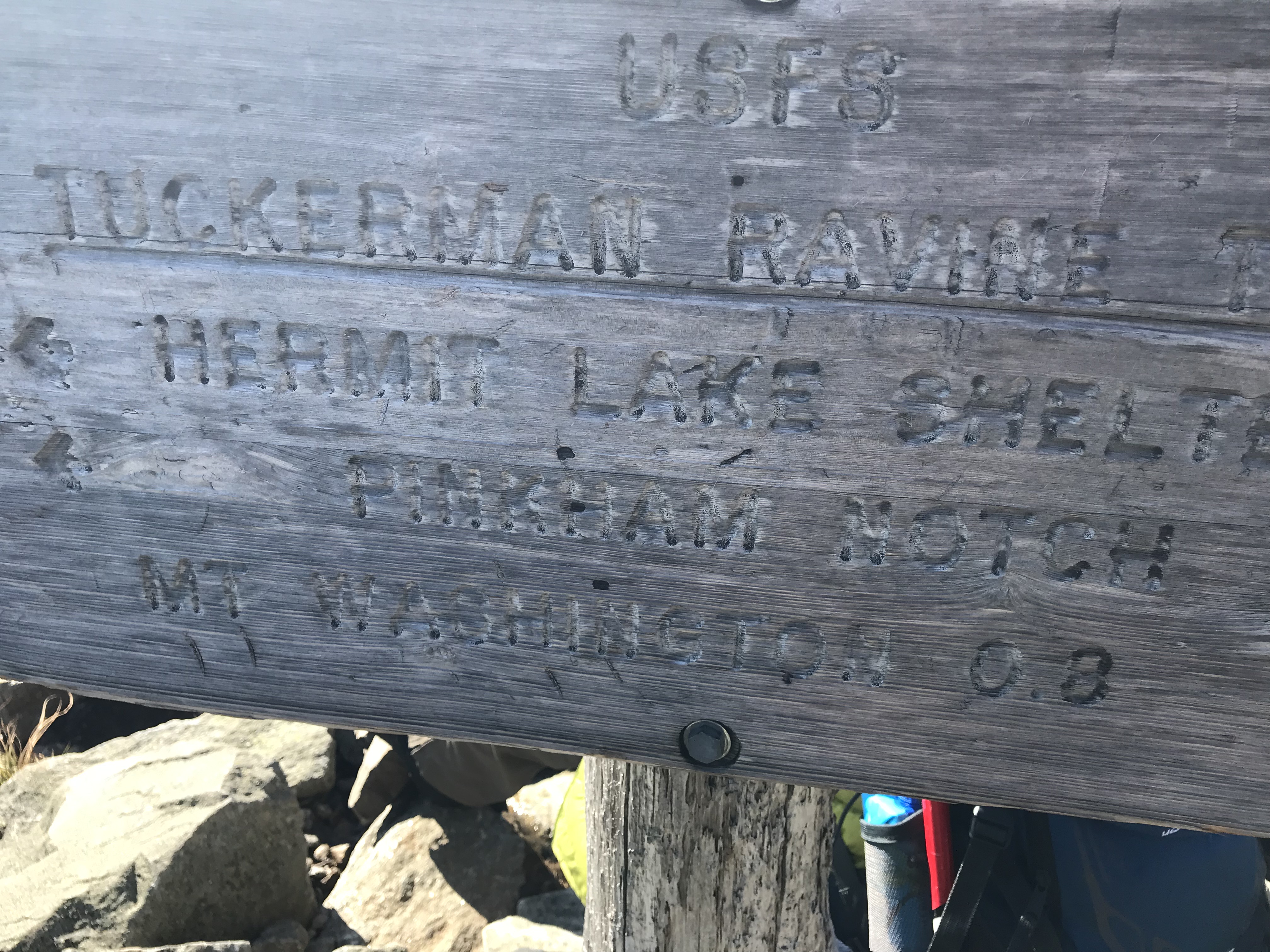
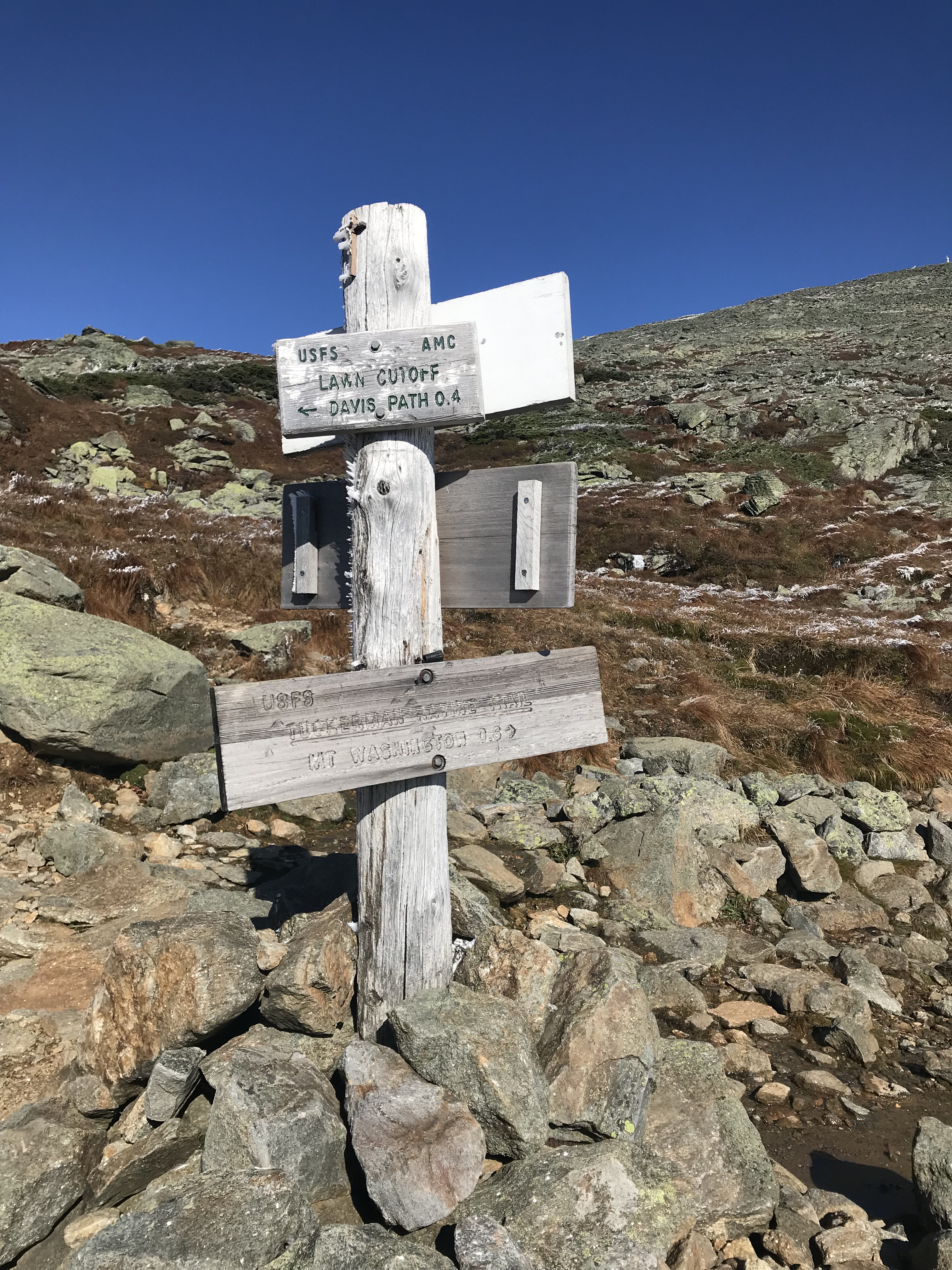
The Boulder Field
This is probably the most deceiving part of the hike. It looks like you are much closer than you actually are and your legs are likely to be pretty tired by now. Climbing up the boulders is a workout and you’ll want to pay attention so that you don’t step into a crevasse or on a loose rock.
There is another wooden sign in the boulder field that will inform you that you are now only .4 of a mile from the summit. I wouldn’t pay much mind to it because it is still going to take another half-hour or so to reach the summit. Just keep pushing onwards because the summit of Mount Washington has a lot to offer!

While climbing the boulder field, you will be following cairns like the one seen below. If the light hits at the right time you can capture some really cool photos!

Mount Washington Summit!
Mount Washington is unlike most mountains because it is accessible by hiking, by car, and by the Mount Washington Cog Railway (yes, a train to the summit). Therefore, you will go from being in the woods and pretty isolated in the White Mountains to being surrounded by a crowd. Most of these people will probably look like tourists and you will look like the Road Trip Warrior that you are, sweaty and worn out from the climb. Fortunately, you can recoup in the summit building.
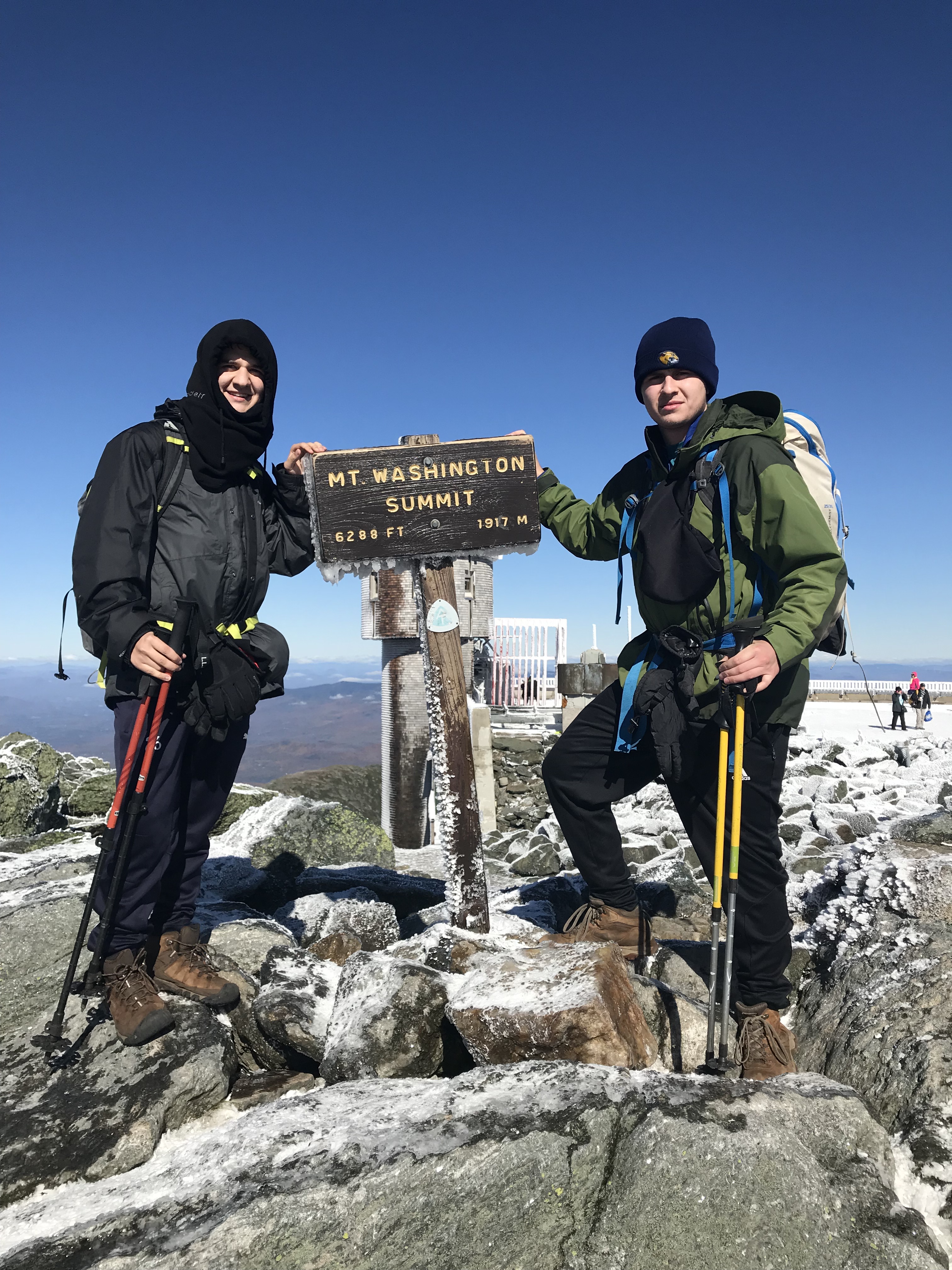
The summit building atop Mount Washington has inside it a museum, a gift shop, a seating area, and a food vendor with offerings such as soup, sandwiches, chips, and various refreshments. It is also heated inside so that is a plus if you hiked up and wanted somewhere to warm up. The gift shop has your typical souvenirs such as clothing, magnets, patches, stickers, and Mount Washington trekking poles. I ended up buying a patch and a sticker (it felt necessary since I hiked it).
The summit of Mount Washington is typically covered in fog about 300 days of the year with a daily average wind speed of 35 miles per hour. On the day I hiked this beast, there was not a cloud in the sky and there was NO WIND on the summit. The type of weather I had is unheard of on the summit of New Hampshire’s highest peak. I was very fortunate and had the opportunity to capture some stunning images. Below you can see the cars and the Mount Washington Cog Railway climbing the mountain.
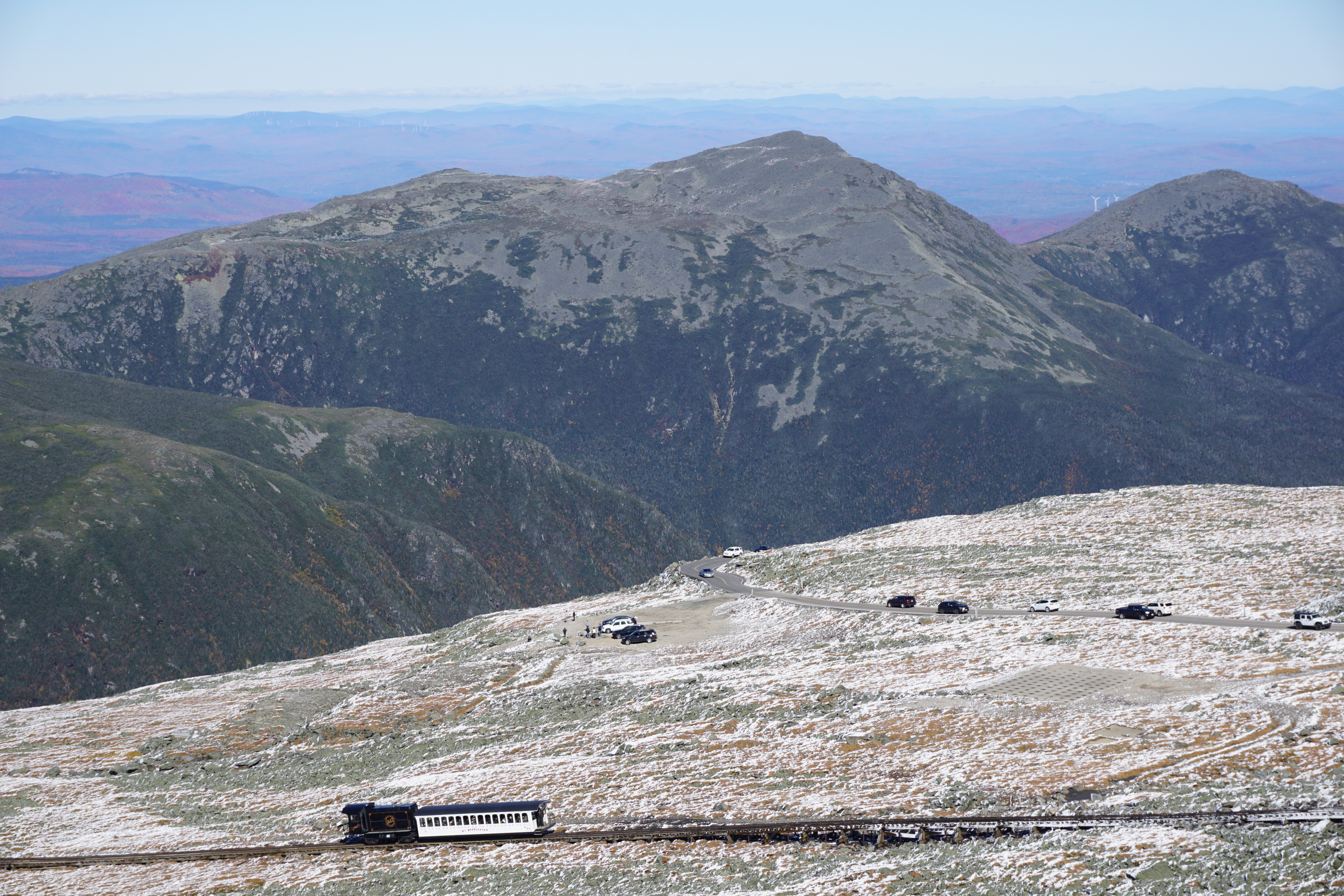
Mount Washington Facts
- Mount Washington is the highest point in the Northeastern United States
- The summit of the mountain was purchased from Dartmouth College to “preserve and develop unusual scenic, scientific, historical, and recreational features for public use and enjoyment – April 1964.”
- The highest wind ever observed by man was recorded here. In a great storm on April 12, 1934 the crews’ instruments measured a wind velocity of 231 miles per hour!!!!
- Some of the buildings on the summit are secured by chains to prevent them from blowing away.
- Over 150 lives have been claimed by this mountain from people being swept off the mountain by winds, suffering heart attacks, suffering hypothermia, and ski accidents.
Getting Back to the Trailhead
There are multiple trails, but I decided to go back down the Tuckerman Ravine Trail to get to my car. I figured that the ice had melted after spending over an hour on the summit and the temperatures rising. I knew that besides descending the ravine, it was a straight-forward hike down. If you decide to go back down this way, just be careful on your descent from the top of the Tuckerman Ravine headwall. There are some sections where falling would be rather painful/deadly.
Dog-Friendly
Mount Washington up the Tuckerman Ravine is dog friendly. I saw numerous dogs hiking up and down the mountain with their owners. I would just be aware of the weather and how your dog might react to it. On the day we went, the weather could not have been more perfect. Therefore, the dogs we saw were seeming to love being outside and jumping from rock to rock. However, when Mount Washington’s usual winds and cold weather picks up I would advise against bringing your furry pal(s).
Fam-Friendly
This hike has the potential to be family-friendly given the right setting. If the weather is fair, this hike is family-friendly (dependent upon fitness level) in my opinion. I think most people underestimate the amount of elevation gain in the 4.2 miles to the summit. Gaining over 4,000′ in elevation in 4 miles is STEEP. That mixed in with bad weather is what makes this hike treacherous. The only break you really get is at the Hermit Lake Shelter, but besides that this hike is pretty relentless in its ascent. If you are out of shape, I don’t recommend attempting this unless you really want to challenge yourself. For those that do want to hike Mount Washington just be mindful of the weather, carry the right gear, and be safe! If you ever need to turn around, then do so. The mountain will always be there for when you return!
Clothes Worn
- Timberland Boots
- Nike Compression Leggings
- Athletic shorts
- Adidas Joggers
- Athletic T-shirt
- Athletic Long Sleeve Pullover
- LL Bean outer shell jacket
- Winter Beanie
- EMS Hiking socks (warmest pair they make)
Gear Brought
- 2L of water
- Almonds and peanut butter granola bars
- Extra hiking socks
- LL Bean mid-layer jacket
- Extra Wind-breaker jacket
- Microspikes (Kahtoola brand)
- Winter Gloves
- Balaclava
- Bandana
- Extra shirts, shorts, and underarmour
- Gaiters
- Wind Pants
- Emergency tents and blankets
- Knife
- Paracord and two carabiners
- Water-proof matches
- LifeStraw (water filtration, costs about $20)
- Trekking poles
- First-Aid Kit
- Garmin inReach (satellite device that has a GPS, can send texts, send SOS, and has many other helpful features)
Omni Mount Washington Resort and Mount Washington
Below you can see Mount Washington tower over the surrounding region and the Omni Mount Washington Resort. Obviously this photo isn’t from the hike, but I wanted to provide it to show the scale of the mountain. Its prominence is 6’148′.
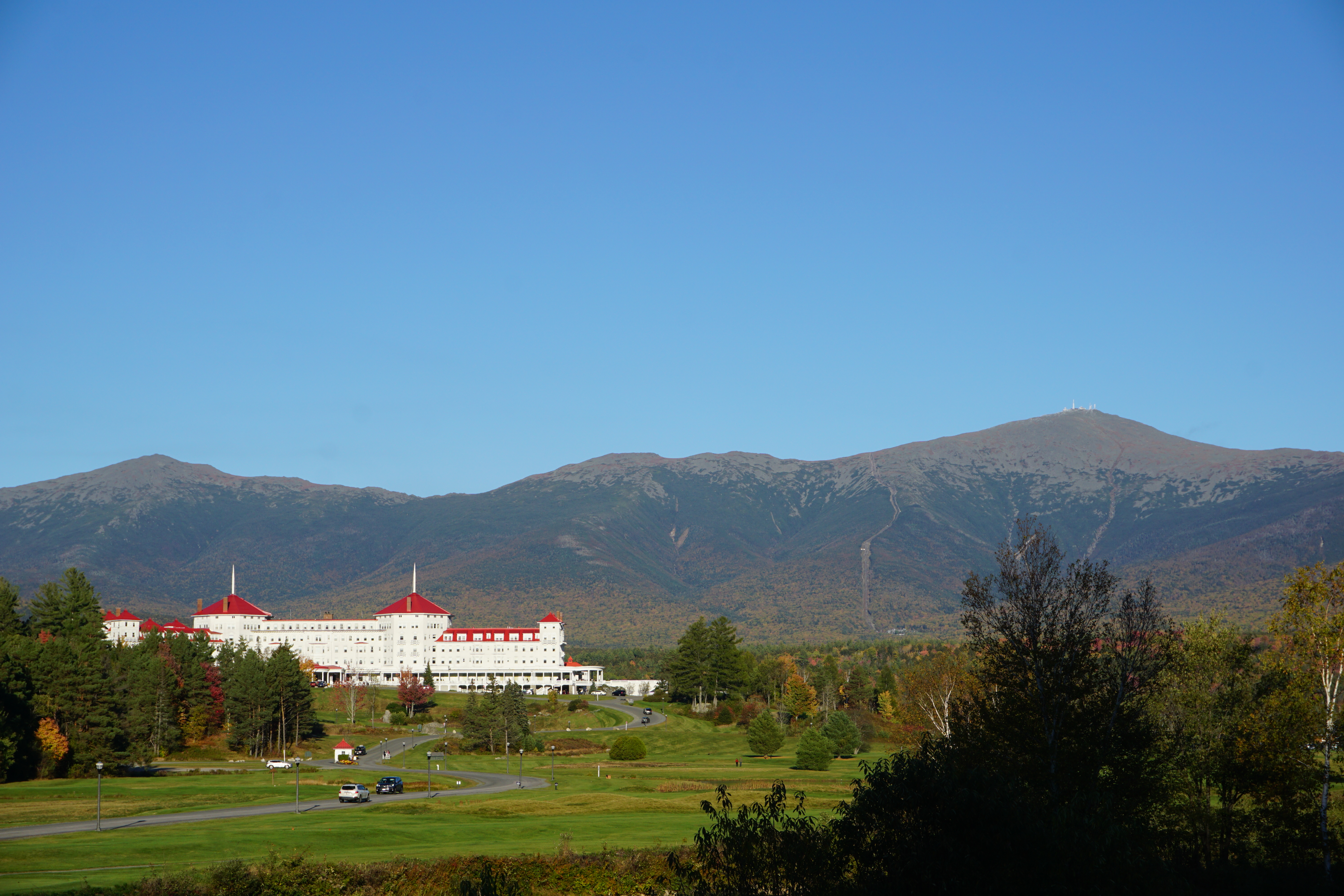
RTW Note
Thank you for taking the time to read about Mount Washington, the hike up Tuckerman Ravine, and the photos I captured along the way. It was probably my favorite hike that I have done in the Northeast. It was the closest environment to hiking in the Rockies that I have encountered in the East. The craggy peaks, crazy weather, and unbelievable views make it a stunning landscape to explore. If you choose to hike Mount Washington, I hope this blog gives you some insight in what to expect and how to prepare. I highly recommend checking out New Hampshire’s highest peak!
To those that have read, liked, commented on, and shared any of these posts, thank you again. I appreciate any and all support. I love being able to share my insight from the places I hike and travel to. If you found this post or any others on my site interesting, helpful, or enjoyable, smash that like button and leave me a comment! Be sure to spread the post as well through your social media outlets! Happy hiking!
-Ant
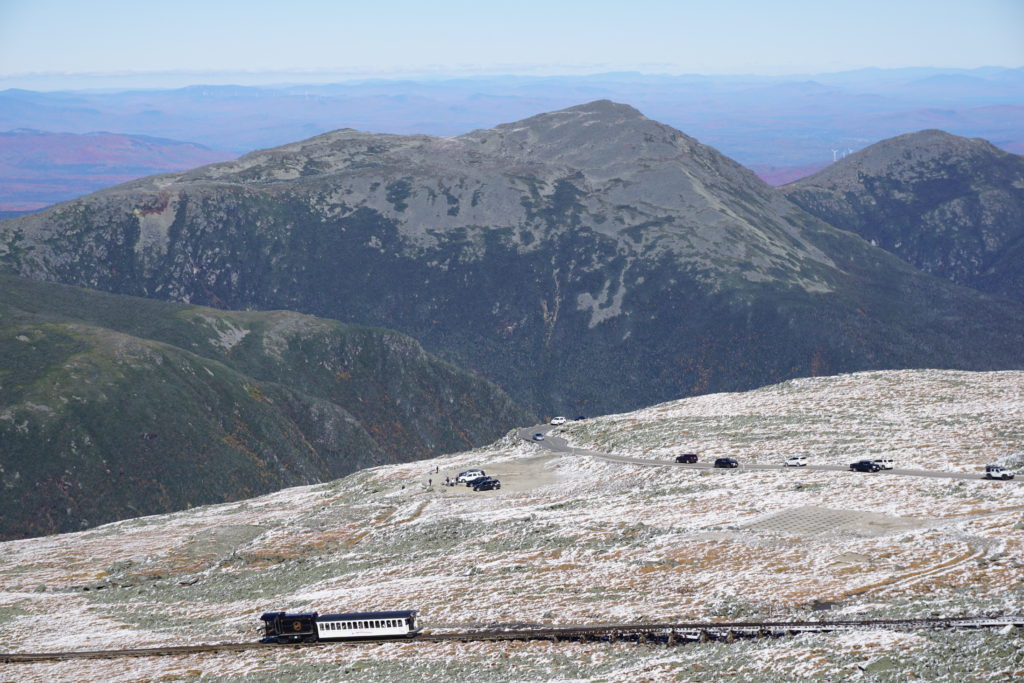

Wow!! Quite a hike!! Your photos are beautiful! Great post!
It was probably my favorite hike in the Northeast! Thank you so much!